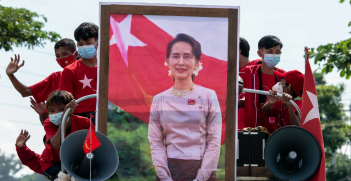High Stakes Strategy in Taiwan

In 2017, the Trump administration launched its first foray into the complex and hostile situation in Taiwan. But behind the smoke and mirrors, what are the actual interests the new administration will have to grapple with in 2018?
On 12 December 2017, President Donald Trump signed the National Defence Authorization Act which specifies the US military budget for 2018. Bipartisan support for authorising USD$700 billion (AUD$900 billion) for the US Defense Department includes overseas military operations. In a press conference on 14 December 2017, when asked about the possibility for US naval operations in Taiwan, Chinese Foreign Ministry Spokesperson Lu Kang’s disapproval was clear:
China firmly opposes all forms of official exchange and military contact between the US and Taiwan as well as the US arms sales to Taiwan.
In light of China’s top diplomat’s closing comment for 2017, what are the strategic interests behind US arms sales to Taiwan?
On 30 June 2017 the US announced a USD$1.4 billion arms deal to Taiwan. Reports on the deal’s implications have been critical towards Trump for being unduly confrontational to China. However, in the months preceding the agreement, Trump’s considerations for the deal were based on a grounded understanding of Chinese, Taiwanese and US strategic interests in the Asia-Pacific region.
As a rising revisionist power, China’s primary interest is to reaffirm a ‘One China’ policy towards Taiwan. Taiwan requires US support to defend its pursuit for self-determination without Chinese interference or coercion. The primary American interest is therefore to exercise its role as a security guarantor over Taiwan to preserve its great power status in the region.
Is change on the cards?
As a new US administration seeks to reassure China that its policies remain largely unchanged, the importance of forging strong bilateral relations between the two great powers is paramount. Yet, it is still within US interests to sell arms to Taiwan. The US is caught between honouring its Taiwanese alliance and also quelling rising Chinese anxiety over its territorial claims. As a way of countering China’s own salami, ‘divide-and conquer’ tactics, the suggestion has been made that the US could incrementally sell defensive arms to Taiwan over a period of time. Continually delivering large arms packages has already spurred rapid Chinese military modernisation over a number of years. A meeting of the annual National People’s Congress confirmed this anxiety, when it announced a 7 per cent rise in the military budget.
While China, Taiwan and the US have shifted their foreign policy to a varying extent, these shifts have not fundamentally altered the strategic interests of each state vis-à-vis the other. There should never be any certainty that trilateral relations will remain as they are, especially given new reformist US and Taiwanese administrations, but each state has not yet demonstrated any signs of changing their strategic objectives.
What are the motivations?
China has taken great interest in the domestic politics of Taiwan in recent years, as the island nation has gone through a transitional government. Whilst there is always an element of the unknown, President Tsai Ing-wen’s Democratic Progressive Party (DPP) will look to neutralise hostile territorial claims from China. Given Taiwan’s long record of arms deals with the US, China’s President Xi Jinping would likely have assumed that Trump’s arms deal would go ahead. Xi will now continue a policy of incremental coercion in an effort to influence Taiwan’s political establishment and derail future arms sales in the long term. Whilst China’s primary goal is to politically unify Taiwan with the mainland, Chinese policy-makers are pragmatic and realistic enough to know that the feasibility of this goal can only be achieved in the long term.
Taiwan will continue to rely on US extended deterrence for its national security. It will therefore continue to pursue arms sales agreements with the US and do whatever possible to preserve the alliance. Based on previous condemnations, China’s negative response to the new deal was predictable. Tsai knew that beyond strong condemnation, China will not escalate its rhetoric into a significant hostile action. Despite espousing unpredictable foreign policy views, Trump was successfully convinced by Tsai and his advisors to honour an important bilateral arms arrangement, knowing a negative backlash for Sino-US relations would be inevitable. As such, Trump will look to build trust and rapport with Xi—a greater foreign policy priority than arms sales with Taiwan. Tsai will look for any opportunity to reaffirm the necessity of future US arms sales to boost Taiwan’s defensive military capability.
Trump has shown an adherence to the ‘One China’ policy in an effort to appease China that it’s business as usual. He has so far maintained the status quo regarding American commitments to Taiwan. Senior military advisors will likely recommend that Trump maintain bilateral military relations as a show of relevance and superiority in the region. However, a US naval presence in Taiwan would be an undue provocation to an already sensitive situation.
To avoid alarming China and disrupting Sino-US relations, the salami tactic of incremental arms packages is a viable option that the US could consider. Large US military transfers to Taiwan such as the sale of 150 fighter jets in 1992 drew strong condemnation from China, raising tensions throughout the region. By making smaller but more regular arms sales to Taiwan, the US is honouring its security arrangement and limiting Chinese anxieties.
China’s perspective
China views US arms sales to Taiwan as a threat to its national and strategic interests. This threat is driven by a deep sense of national humiliation suffered under foreign rulers during its imperial past. This narrative has been espoused by Chinese foreign policy-makers to promote nationalistic sentiment at home. For China, national pride is at stake with regard to Taiwan in its pursuit for national rejuvenation. The US presence in Taiwan threatens the source of this national pride and revives painful historical memories of foreign encroachment and occupation. Given that China believes Taiwan to be indivisible from the PRC, US arms deals to a secessionist Taiwan is viewed by China as hostile anti-Chinese behaviour.
Taiwanese prospects
Taiwan is at the centre of a great power contest as it struggles to achieve sovereignty from its powerful mainland neighbour, whilst having the freedom to pursue greater relations with the West. As an island nation that has forged a distinct political and social identity from the mainland, Taiwan’s foreign policy towards China has consistently been one of self-determination. In an effort to achieve independence, successive Taiwanese leaders have sought greater defensive military capabilities to deter a potential Chinese assault.
In December 2016, President Tsai Ing-wen angered China by calling President Trump to congratulate his win and reaffirm the alliance. With Trump’s recent arms sales approval, Taiwanese defence policy-makers have been appeased after months of uncertainty. Taiwanese efforts to boost its military capability has become a national priority as it looks to counterbalance a more assertive China. Whilst Taiwan does not have the capability to defeat a conventional Chinese assault, it could inflict enough damage for the cost to be too great to warrant attempting.
President Tsai is faced with Taiwan’s usual foreign policy dilemma—appeasing China whilst still relying on US security commitments. Through decades of careful diplomatic manoeuvring, Taiwan has been able to strike an uneasy balance between the US and China which Tsai will want to preserve. So far, she has kept satisfactory cross-strait relations by keeping to the status quo. However challenges will always remain for any Taiwanese leader who must play off two competing great powers.
Reid Hutchins completed a Master of Strategic Studies at the Australian National University and is currently a Ministerial Liaison Officer at the ACT Government.
This article is published under a Creative Commons Licence and may be republished with attribution.





